2017 MERCEDES-BENZ GLE interior lights
[x] Cancel search: interior lightsPage 4 of 390

Index ....................................................... 4
Introduction ......................................... 25
Protecting the environment .................. .2 5
Genuine Mercedes-Benz parts .............. .2 5
Operator's Manual ................................. 26
Service and vehicle operation ............... .2 6
Operating safety .................................... 28
QR codes for the rescue card ............... .3 0
Data stored in the vehicle ...................... 30
Information on copyright ....................... 32
At a glance ........................................... 33
Cockpit .................................................. 33
Instrument cluster ................................. 34
Multifunction steering wheel ................. 35
Center console ...................................... 36
Overhead control panel ........................ .3 9
Door control panel ................................. 40
Safety ................................................... 41
Panic alarm ............................................ 41
Occupant safety .................................... 41
Children in the vehicle ........................... 57
Pets in the vehicle ................................. 62
Driving safety systems ........................... 62
Protection against theft ........................ .7 2
Opening and closing ........................... 74
SmartKey ............................................... 74
Doors ..................................................... 80
Cargo compartment .............................. .8 1
Side windows ......................................... 85
Sliding sunroof ....................................... 89
Seats, steering wheel and mirrors .... 94
Correct driver's seat position ................ 94
Seats ..................................................... 94
Steering wheel ..................................... 100
Mirrors ................................................. 102
Memory function ................................. 105
Lights and windshield wipers .......... 107
Exterior lighting ................................... 107 Interior lighting .................................... 111
Replacing bulbs (vehicles with LED
headlamps) .......................................... 112
Replacing bulbs (vehicles with halo-
gen headlamps) ................................... 112
Windshield wipers ................................ 114
Climate control ................................. 119
Overview of climate control systems ... 119
Operating the climate control sys-
tems .................................................... 124
Setting the air vents ............................ 129
Driving and parking .......................... 131
Notes on breaking-in a new vehicle ..... 131
Driving ................................................. 131
DYNAMIC SELECT controller ............... 139
Automatic transmission ....................... 140
Refueling ............................................. 147
Parking ................................................ 153
Driving tips .......................................... 156
Driving systems ................................... 166
Towing a trailer .................................... 215
On-board computer and displays .... 223
Important safety notes ........................ 223
Displays and operation ........................ 223
Menus and submenus ......................... 226
Display messages ................................ 237
Warning and indicator lamps in the
instrument cluster ............................... 268
Multimedia system ........................... 281
General notes ...................................... 281
Important safety notes ........................ 281
Function restrictions ............................ 281
Operating system ................................ 282
Stowage and features ...................... 288
Stowage areas ..................................... 288
Features .............................................. 298
Maintenance and care ...................... 314
Engine compartment ........................... 314
ASSYST PLUS ...................................... 3182
Contents
Page 8 of 390

AUX ja cks
CD/DVD driv e .............................. .2 87
Axle load, permissible (trailer tow-
ing) ...................................................... 384
BBack button ....................................... 282
Bag hook ............................................ 293
Ball coupling
Installing ........................................ 217
Removing ....................................... 221
BAS (Brake Assist System) ................. 63
Battery (SmartKey)
Checking .......................................... 77
Important safety notes .................... 77
Replacing ......................................... 77
Battery (vehicle)
Charging ........................................ 333
Display message ............................ 252
Important safety notes .................. 331
Jump starting ................................. 333
Overview ........................................ 331
Belt
see Seat belts
Blind Spot Assist
Activating/deactivating ................. 232
Display message ............................ 259
Notes/function .............................. 201
Trailer towing ................................. 203
see Active Blind Spot Assist
Blootooth ®
Connecting a different mobile
phone ............................................ 286
BlueTEC
Adding DEF ................................... .1 50
BlueTEC (DEF) ................................... .3 76
Bluetooth ®
Searching for a mobile phone ....... .2 85
see also Digital Operator's Man-
ual ................................................. .2 81
Telephony ...................................... 284
Brake Assist
see BAS (Brake Assist System)
Brake fluid
Display message ............................ 244
Notes ............................................. 378 Brake force distribution
see EBD (electronic brake force
distribution)
Brake lamps
Display message ............................ 250
Brakes
ABS ................................................. .6 3
Adaptive Brake Assist ...................... 65
BAS .................................................. 63
Brake fluid (notes) ......................... 378
Display message ............................ 239
High-performance brake system .... 160
Hill start assist ............................... 136
Important safety notes .................. 158
Maintenance .................................. 159
Parking bra ke ................................ 154
R i ding tips ...................................... 158
Warning lamp ................................. 270
Breakdown
Where will I find...? ........................ 326
see Flat tire
see Towing away
Brightness control (instrument
cluster lighting) ................................... 34
Bulbs
see Replacing bulbs
C
California
Important notice for retail cus-
tomers and lessees .......................... 26
Calling up a malfunction
see Display messages
Car
see Vehicle
Care
360° camera ................................. 323
Car wash ........................................ 319
Carpets .......................................... 325
Display ........................................... 324
Exhaust pipe .................................. 323
Exterior lights ................................ 322
Gear or selector lever .................... 324
Interior ........................................... 324
Matte finish ................................... 321
Notes ............................................. 319
Paint .............................................. 3216
Index
Page 15 of 390

Indicators
see Turn signals
Insect protection on the radiator .... 315
Instrument cluster
Overview .......................................... 34
Warning and indicator lamps .......... .3 4
Instrument cluster lighting .............. 223
Intelligent Light System
Activating/deactivating ................ .2 33
Overview ........................................ 109
Interior lighting
Automatic control .......................... 112
Emergency lighting ........................ 112
General notes ................................ 111
Manual control ............................... 111
Overview ........................................ 111
Reading lamp ................................. 111
iPod ®
see also Digital Operator's Man-
ual ................................................. .2 81
J Jack
Storage location ............................ 326
Using ............................................. 363
Jump starting (engine) ..................... .3 33
K
Key positions
KEYLESS-GO .................................. 132
SmartKey ....................................... 132
KEYLESS-GO
Activating ......................................... 75
Convenience closing feature ............ 88
Deactivation ..................................... 75
Display message ............................ 267
Locking ............................................ 75
Removing the Start/Stop button ... 133
Start function ................................... 76
Start/Stop button .......................... 132
Starting the engine ........................ 134
Unlocking ......................................... 75
Kickdown
Driving tips ................................... .1 43
Manual gearshifting ....................... 146
Knee bag .............................................. 47 L Lamps
see Warning and indicator lamps
Lane detection (automatic)
see Lane Keeping Assist
Lane Keeping Assist
Activating/deactivating ................. 232
Display message ............................ 258
Function/information .................... 203
see Active Lane Keeping Assist
Lap time (RACETIMER) ...................... 236
LATCH-type (ISOFIX) child seat
anchors ................................................ 59
Level control
AIRMATIC ...................................... 182
Level control (display message) ...... 255
Level control (vehicle with the Off-
Road Engineering package)
Basic settings ................................ 176
Function/notes ............................. 176
Important safety notes .................. 176
License plate lamp (display mes-
sage) ................................................... 250
Light function, active
Display message ............................ 250
Light sensor (display message) ....... 250
Lights
Activating/deactivating the Intel-
ligent Light System ........................ 233
Active light function ....................... 109
Adaptive Highbeam Assist ............. 110
Automatic headlamp mode ............ 107
Fog lamps (extended) .................... 110
Hazard warning lamps ................... 109
High beam flasher .......................... 108
High-beam headlamps ................... 108
Highway mode ............................... 110
Light switch ................................... 107
Low-beam headlamps .................... 108
Off-road lights ................................ 110
Parking lamps ................................ 108
Rear fog lamp ................................ 108
Standing lamps .............................. 108
Switching the daytime running
lamps on/off (on-board com-
puter) ............................................. 233
Turn signals ................................... 108 Index 13
Page 44 of 390
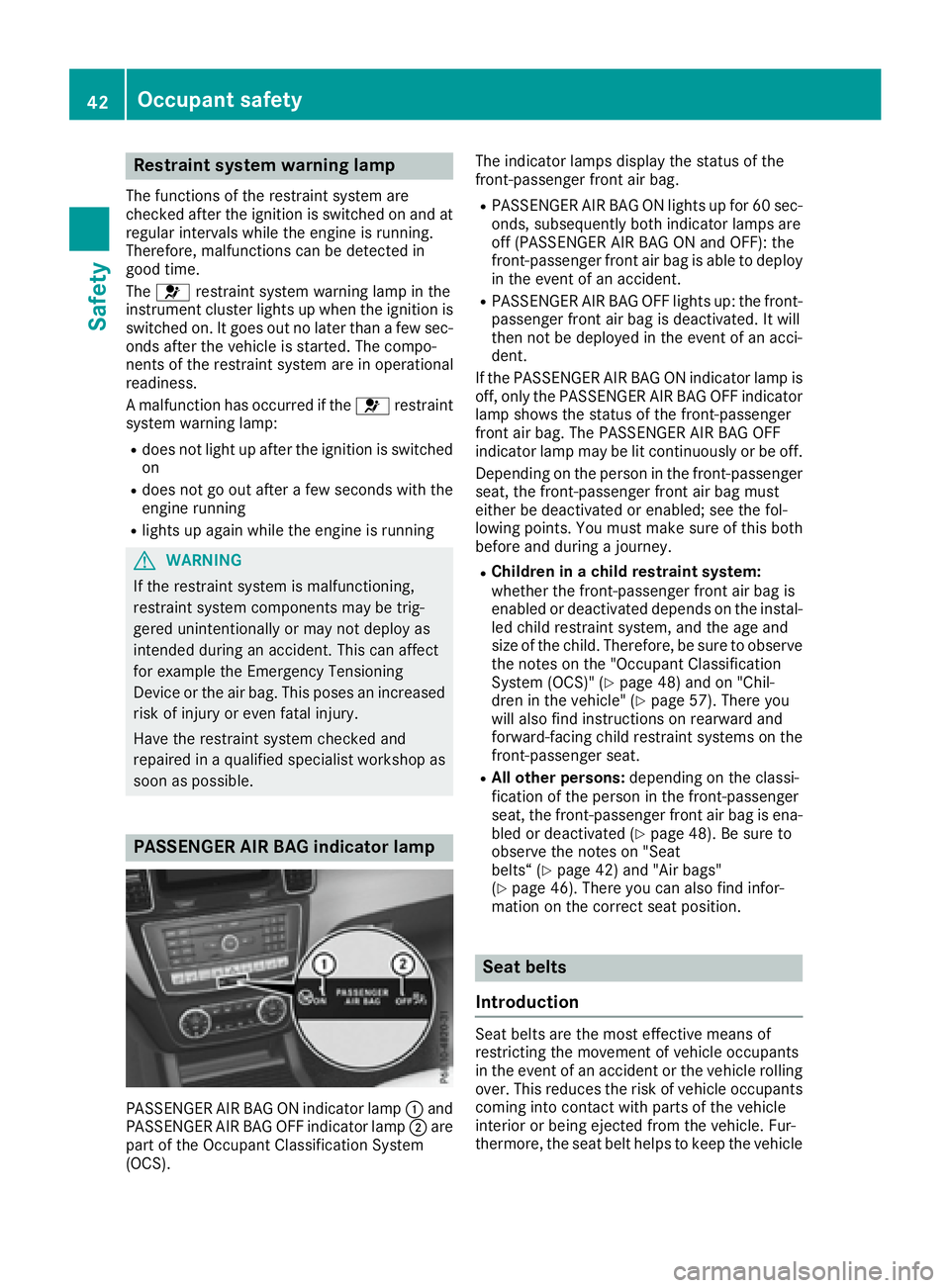
Restraint system warning lamp The functions of the restraint system are
checked after the ignition is switched on and at
regular intervals while the engine is running.
Therefore, malfunctions can be detected in
good time.
The �u restraint system warning lamp in the
instrument cluster lights up when the ignition is
switched on. It goes out no later than a few sec-
onds after the vehicle is started. The compo-
nents of the restraint system are in operational
readiness.
A malfunction has occurred if the �u restraint
system warning lamp: R
does not light up after the ignition is switched
on R
does not go out after a few seconds with the
engine running R
lights up again while the engine is running
G WARNING
If the restraint system is malfunctioning,
restraint system components may be trig-
gered unintentionally or may not deploy as
intended during an accident. This can affect
for example the Emergency Tensioning
Device or the air bag. This poses an increased
risk of injury or even fatal injury.
Have the restraint system checked and
repaired in a qualified specialist workshop as
soon as possible.
PASSENGER AIR BAG indicator lamp
PASSENGER AIR BAG ON indicator lamp �C and
PASSENGER AIR BAG OFF indicator lamp �D are
part of the Occupant Classification System
(OCS). The indicator lamps display the status of the
front-passenger front air bag. R
PASSENGER AIR BAG ON lights up for 60 sec-
onds, subsequently both indicator lamps are
off (PASSENGER AIR BAG ON and OFF): the
front-passenger front air bag is able to deploy
in the event of an accident. R
PASSENGER AIR BAG OFF lights up: the front-
passenger front air bag is deactivated. It will
then not be deployed in the event of an acci-
dent.
If the PASSENGER AIR BAG ON indicator lamp is
off, only the PASSENGER AIR BAG OFF indicator
lamp shows the status of the front-passenger
front air bag. The PASSENGER AIR BAG OFF
indicator lamp may be lit continuously or be off.
Depending on the person in the front-passenger
seat, the front-passenger front air bag must
either be deactivated or enabled; see the fol-
lowing points. You must make sure of this both
before and during a journey. R
Children in a child restraint system:
whether the front-passenger front air bag is
enabled or deactivated depends on the instal-
led child restraint system, and the age and
size of the child. Therefore, be sure to observe
the notes on the "Occupant Classification
System (OCS)" ( Y
page 48) and on "Chil-
dren in the vehicle" ( Y
page 57). There you
w ill also find instructions on rearward and
forward-facing child restraint systems on the
front-passenger seat. R
All other persons: depending on the classi-
fication of the person in the front-passenger
seat, the front-passenger front air bag is ena-
bled or deactivated ( Y
page 48). Be sure to
observe the notes on "Seat
belts“ ( Y
page 42) and "Air bags"
( Y
page 46). There you can also find infor-
mation on the correct seat position.
Seat belts
Introduction
Seat belts are the most effective means of
restricting the movement of vehicle occupants
in the event of an accident or the vehicle rolling
over. This reduces the risk of vehicle occupants
coming into contact with parts of the vehicle
interior or being ejected from the vehicle. Fur-
thermore, the seat belt helps to keep the vehicle42
Occupant safety
Safety
Page 52 of 390
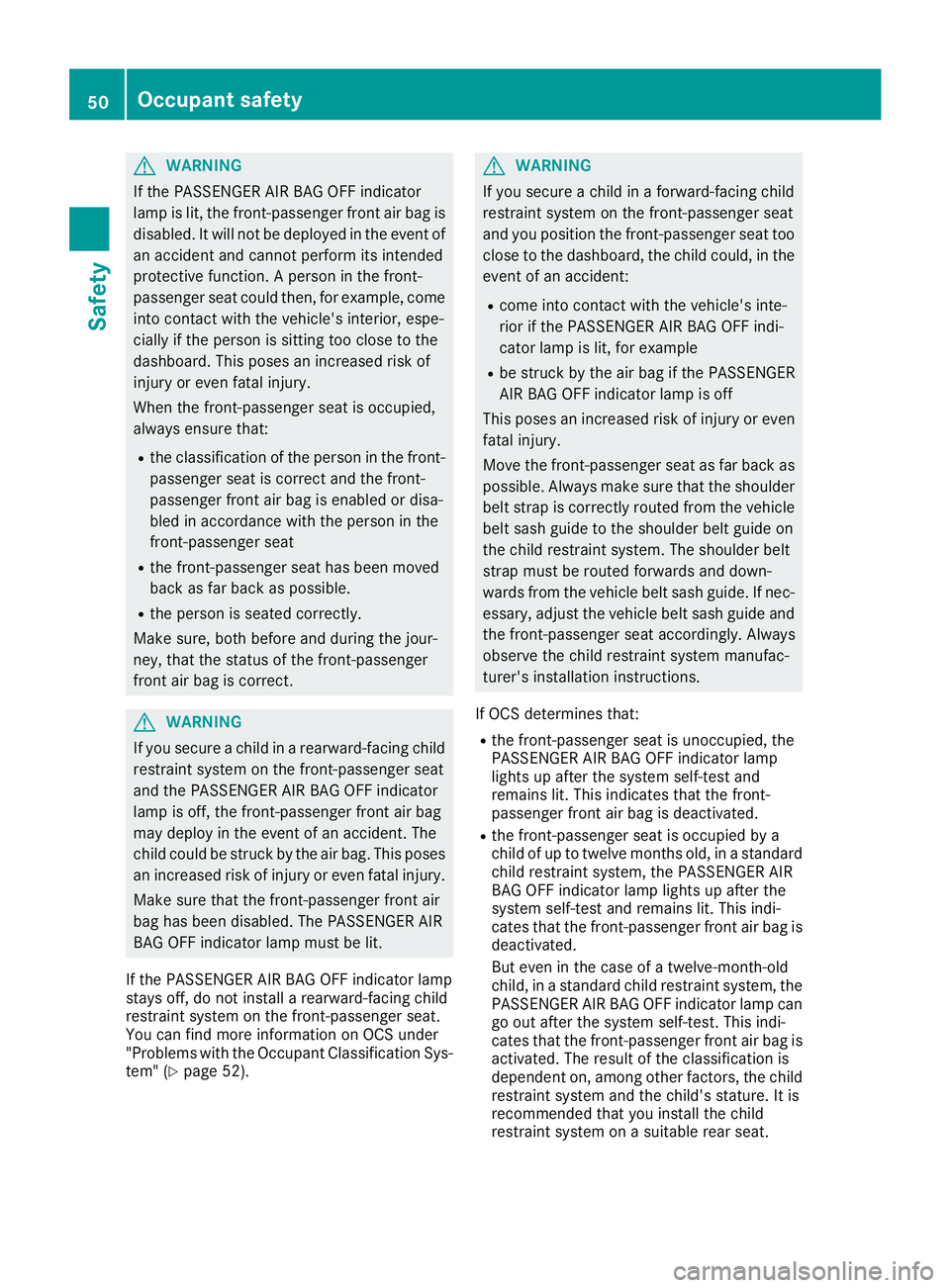
G WARNING
If the PASSENGER AIR BAG OFF indicator
lamp is lit, the front-passenger front air bag is
disabled. It will not be deployed in the event of
an accident and cannot perform its intended
protective function. A person in the front-
passenger seat could then, for example, come
into contact with the vehicle's interior, espe-
cially if the person is sitting too close to the
dashboard. This poses an increased risk of
injury or even fatal injury.
When the front-passenger seat is occupied,
always ensure that: R
the classification of the person in the front-
passenger seat is correct and the front-
passenger front air bag is enabled or disa-
bled in accordance with the person in the
front-passenger seat R
the front-passenger seat has been moved
back as far back as possible. R
the person is seated correctly.
Make sure, both before and during the jour-
ney, that the status of the front-passenger
front air bag is correct.
G WARNING
If you secure a child in a rearward-facing child
restraint system on the front-passenger seat
and the PASSENGER AIR BAG OFF indicator
lamp is off, the front-passenger front air bag
may deploy in the event of an accident. The
child could be struck by the air bag. This poses
an increased risk of injury or even fatal injury.
Make sure that the front-passenger front air
bag has been disabled. The PASSENGER AIR
BAG OFF indicator lamp must be lit.
If the PASSENGER AIR BAG OFF indicator lamp
stays off, do not install a rearward-facing child
restraint system on the front-passenger seat.
You can find more information on OCS under
"Problems with the Occupant Classification Sys-
tem" ( Y
page 52). G WARNING
If you secure a child in a forward-facing child
restraint system on the front-passenger seat
and you position the front-passenger seat too
close to the dashboard, the child could, in the
event of an accident: R
come into contact with the vehicle's inte-
rior if the PASSENGER AIR BAG OFF indi-
cator lamp is lit, for example R
be struck by the air bag if the PASSENGER
AIR BAG OFF indicator lamp is off
This poses an increased risk of injury or even
fatal injury.
Move the front-passenger seat as far back as
possible. Always make sure that the shoulder
belt strap is correctly routed from the vehicle
belt sash guide to the shoulder belt guide on
the child restraint system. The shoulder belt
strap must be routed forwards and down-
wards from the vehicle belt sash guide. If nec-
essary, adjust the vehicle belt sash guide and
the front-passenger seat accordingly. Always
observe the child restraint system manufac-
turer's installation instructions.
If OCS determines that: R
the front-passenger seat is unoccupied, the
PASSENGER AIR BAG OFF indicator lamp
lights up after the system self-test and
remains lit. This indicates that the front-
passenger front air bag is deactivated. R
the front-passenger seat is occupied by a
child of up to twelve months old, in a standard
child restraint system, the PASSENGER AIR
BAG OFF indicator lamp lights up after the
system self-test and remains lit. This indi-
cates that the front-passenger front air bag is
deactivated.
But even in the case of a twelve-month-old
child, in a standard child restraint system, the
PASSENGER AIR BAG OFF indicator lamp can
go out after the system self-test. This indi-
cates that the front-passenger front air bag is
activated. The result of the classification is
dependent on, among other factors, the child
restraint system and the child's stature. It is
recommended that you install the child
restraint sy stem on a suitable rear seat.50
Occupant safety
Safety
Page 53 of 390
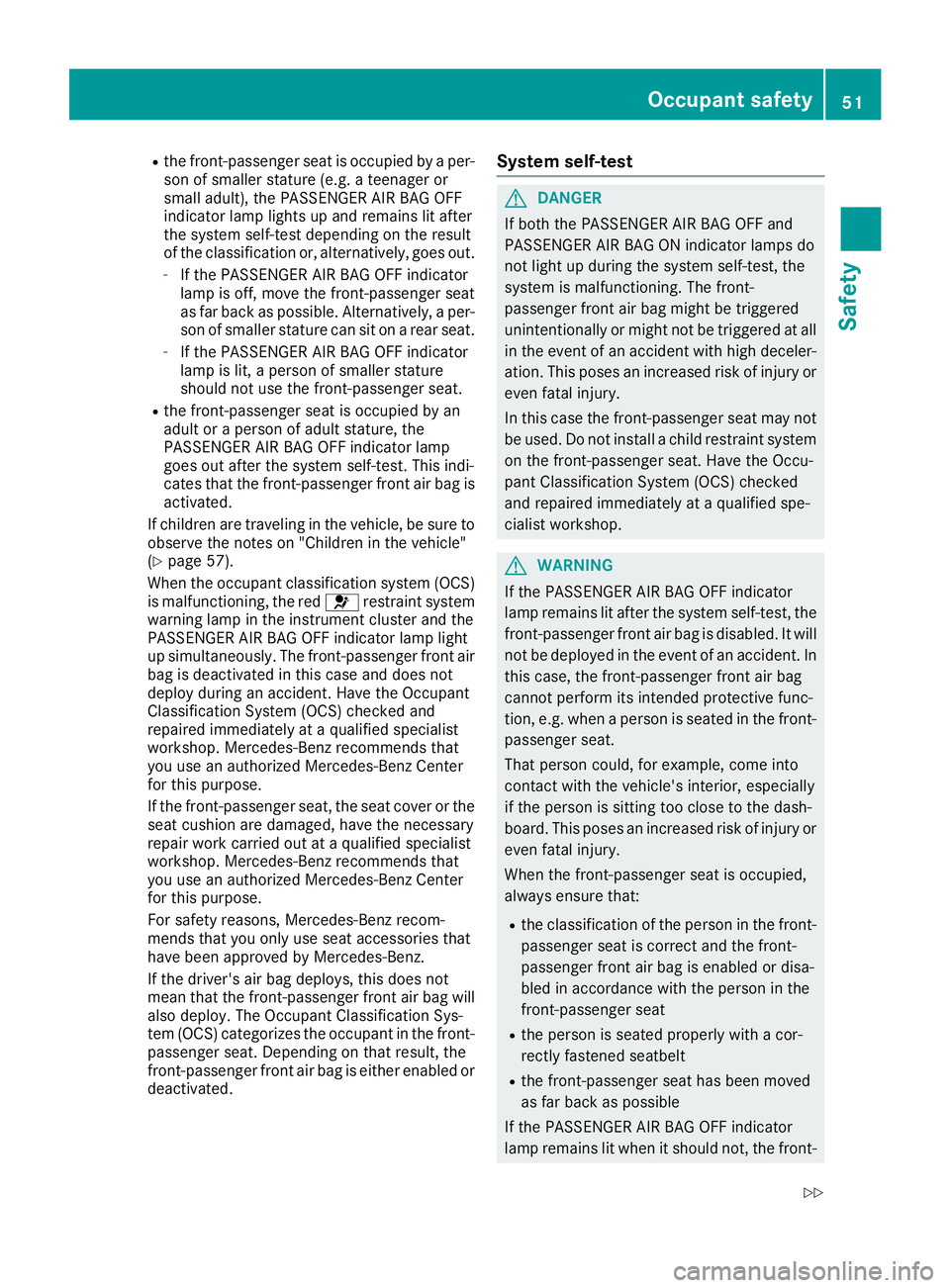
R
the front-passenger seat is occupied by a per-
son of smaller stature (e.g. a teenager or
small adult), the PASSENGER AIR BAG OFF
indicator lamp lights up and remains lit after
the system self-test depending on the result
of the classification or, alternatively, goes out. -
If the PASSENGER AIR BAG OFF indicator
lamp is off, move the front-passenger seat
as far back as possible. Alternatively, a per-
son of smaller stature can sit on a rear seat. -
If the PASSENGER AIR BAG OFF indicator
lamp is lit, a person of smaller stature
should not use the front-passenger seat. R
the front-passenger seat is occupied by an
adult or a person of adult stature, the
PASSENGER AIR BAG OFF indicator lamp
goes out after the system self-test. This indi-
cates that the front-passenger front air bag is
activated.
If children are traveling in the vehicle, be sure to
observe the notes on "Children in the vehicle"
( Y
page 57).
When the occupant classification system (OCS)
is malfunctioning, the red �u restraint system
warning lamp in the instrument cluster and the
PASSENGER AIR BAG OFF indicator lamp light
up simultaneously. The front-passenger front air
bag is deactivated in thi s ca se and does not
d
eploy during an accident. Have the Occupant
Classification System (OCS) checked and
repaired immediately at a qualified specialist
workshop. Mercedes-Benz recommends that
you use an authorized Mercedes-Benz Center
for this purpose.
If the front-passenger seat, the seat cover or the
seat cushion are damaged, have the necessary
repair work carried out at a qualified specialist
workshop. Mercedes-Benz recommends that
you use an authorized Mercedes-Benz Center
for this purpose.
For safety reasons, Mercedes-Benz recom-
mends that you only use seat accessories that
have been approved by Mercedes-Benz.
If the driver's air bag deploys, this does not
mean that the front-passenger front air bag will
also deploy. The Occupant Classification Sys-
tem (OCS) categorizes the occupant in the front-
passenger seat. Depending on that result, the
front-passenger front air bag is either enabled or
deactivated. System self-test
G DANGER
If both the PASSENGER AIR BAG OFF and
PASSENGER AIR BAG ON indicator lamps do
not light up during the system self-test, the
system is malfunctioning. The front-
passenger front air bag might be triggered
unintentionally or might not be triggered at all
in the event of an accident with high deceler-
ation. This poses an increased risk of injury or
even fatal injury.
In this case the front-passenger seat may not
be used. Do not install a child restraint system
on the front-passenger seat. Have the Occu-
pant Classification System (OCS) checked
and repaired immediately at a qualified spe-
cialist workshop.
G WARNING
If the PASSENGER AIR BAG OFF indicator
lamp remains lit after the system self-test, the
front-passenger front air bag is disabled. It will
not be deployed in the event of an accident. In
this case, the front-passenger front air bag
cannot perform its intended protective func-
tion, e.g. when a person is seated in the front-
passenger seat.
That person could, for example, come into
contact with the vehicle's interior, especially
if the person is sitting too close to the dash-
board. This poses an increased risk of injury or
even fatal injury.
When the front-passenger seat is occupied,
always ensure that: R
the classification of the person in the front-
passenger seat is correct and the front-
passenger front air bag is enabled or disa-
bled in accordance with the person in the
front-passenger seat R
the person is seated properly with a cor-
rectly fastened seatbelt R
the front-passenger seat has been moved
as far back as possible
If the PASSENGER AIR BAG OFF indicator
lamp remains lit when it should not, the front-Occupant safety 51
Safety Z
Page 136 of 390
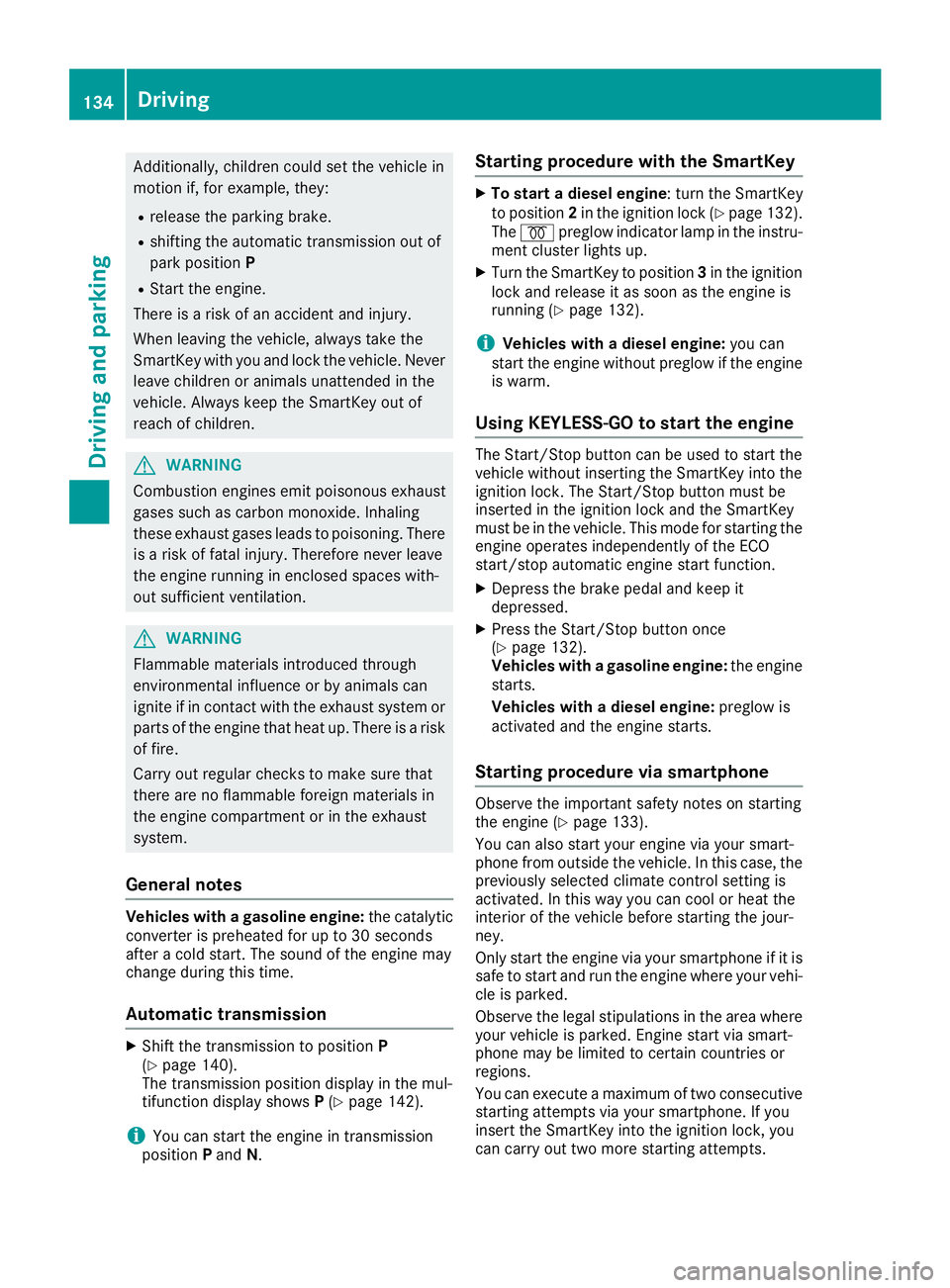
Additionally, children could set the vehicle in
motion if, for example, they: R
release the parking brake. R
shifting the automatic transmission out of
park position PR
Start the engine.
There is a risk of an accident and injury.
When leaving the vehicle, always take the
SmartKey with you and lock the vehicle. Never
leave children or animals unattended in the
vehicle. Always keep the SmartKey out of
reach of children.
G WARNING
Combustion engines emit poisonous exhaust
gases such as carbon monoxide. Inhaling
these exhaust gases leads to poisoning. There
is a risk of fatal injury. Therefore never leave
the engine running in enclosed spaces with-
out sufficient ventilation.
G WARNING
Flammable materials introduced through
environmental influence or by animals can
ignite if in contact with the exhaust system or
parts of the engine that heat up. There is a risk
of fire.
Carry out regular checks to make sure that
there are no flammable foreign materials in
the engine compartment or in the exhaust
system.
General notes Vehicles with a gasoline engine: the catalytic
converter is preheated for up to 30 seconds
after a cold start. The sound of the engine may
change during this time.
Automatic transmission X
Shift the transmission to position P
( Y
page 140).
The transmission position display in the mul-
tifunction display shows P ( Y
page 142).
i You can start the engine in transmission
position P and N . Starting procedure with the SmartKey X
To start a diesel engine : turn the SmartKey
to position 2 in the ignition lock ( Y
page 132).
The �\( preglow indicator lamp in the instru-
ment cluster lights up. X
Turn the SmartKey to position 3 in the ignition
lock and release it as soon as the engine is
running ( Y
page 132).
i Vehicles with a diesel engine: you can
start the engine without preglow if the engine
is warm.
Using KEYLESS-GO to start the engine The Start/Stop button can be used to start the
vehicle without inserting the SmartKey into the
ignition lock. The Start/Stop button must be
inserted in the ignition lock and the SmartKey
must be in the vehicle. This mode for starting the
engine operates independently of the ECO
start/stop automatic engine start function. X
Depress the brake pedal and keep it
depressed. X
Press the Start/Stop button once
( Y
page 132).
Vehicles with a gasoline engine: the engine
starts.
Vehicles with a diesel engine: preglow is
activated and the engine starts.
Starting procedure via smartphone Observe the important safety notes on starting
the engine ( Y
page 133).
You can also start your engine via your smart-
phone from outside the vehicle. In this case, the
previously selected climate control setting is
activated. In this way you can cool or heat the
interior of the vehicle before starting the jour-
ney.
Only start the engine via your smartphone if it is
safe to start and run the engine where your vehi-
cle is parked.
Observe the legal stipulations in the area where
your vehicle is parked. Engine start via smart-
phone may be limited to certain countries or
regions.
You can execute a maximum of two consecutive
starting attempts via your smartphone. If you
insert the SmartKey into the ignition lock, you
can carry out two more starting attempts.134
Driving
Driving an d parking
Page 139 of 390
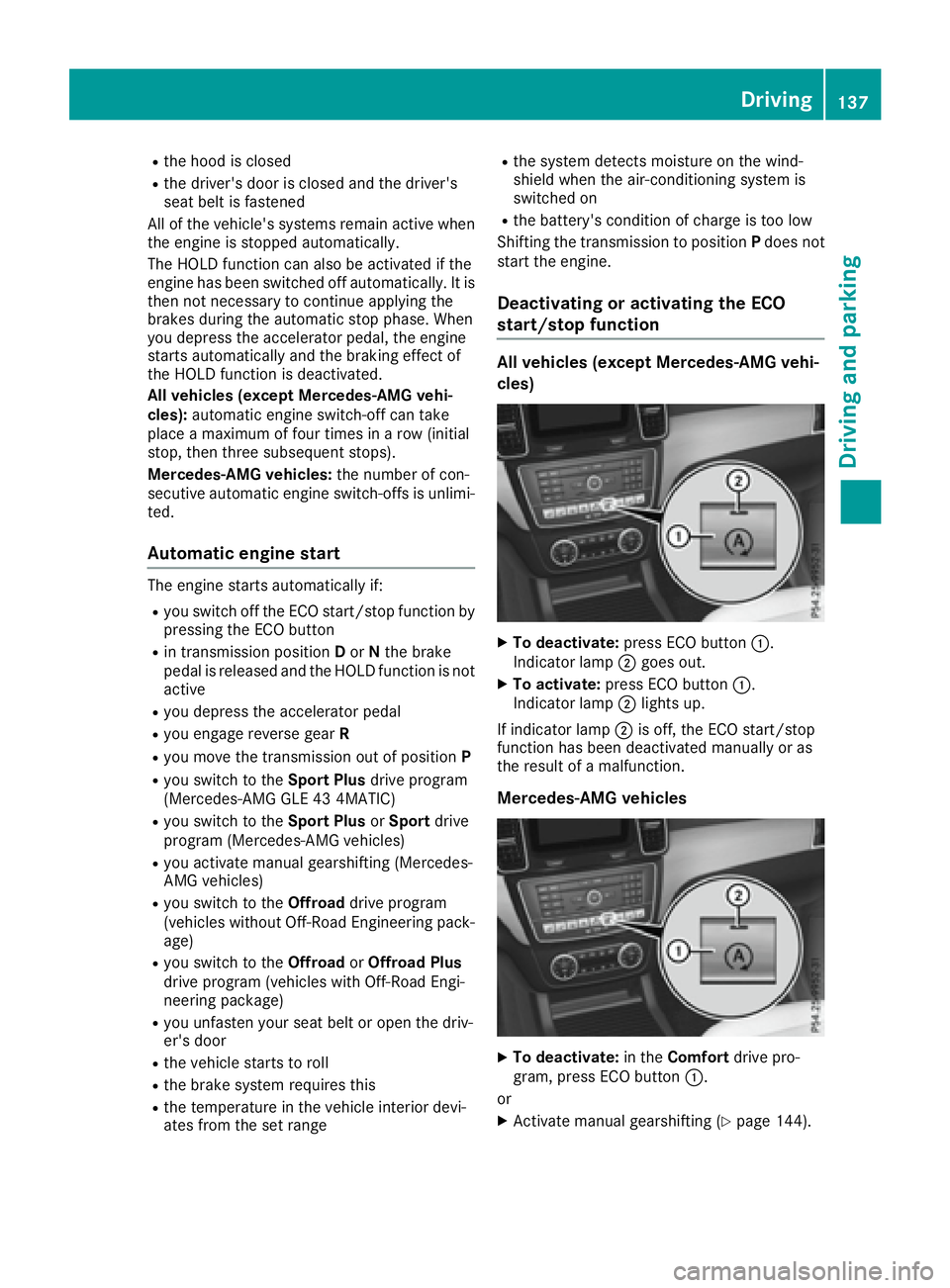
R
the hood is closed R
the driver's door is closed and the driver's
seat belt is fastened
All of the vehicle's systems remain active when
the engine is stopped automatically.
The HOLD function can also be activated if the
engine has been switched off automatically. It is
then not necessary to continue applying the
brakes during the automatic stop phase. When
you depress the accelerator pedal, the engine
starts automatically and the braking effect of
the HOLD function is deactivated.
All vehicles (except Mercedes-AMG vehi-
cles): automatic engine switch-off can take
place a maximum of four times in a row (initial
stop, then three subsequent stops).
Mercedes-AMG vehicles: the number of con-
secutive automatic engine switch-offs is unlimi-
ted.
Automatic engine start The engine starts automatically if: R
you switch off the ECO start/stop function by
pressing the ECO button R
in transmission position D or N the brake
pedal is released and the HOLD function is not
active R
you depress the accelerator pedal R
you engage reverse gear RR
you move the transmission out of position PR
you switch to the Sport Plus drive program
(Mercedes-AMG GLE 43 4MATIC) R
you switch to the Sport Plus or Sport drive
program (Mercedes-AMG vehicles) R
you activate manual gearshifting (Mercedes-
AMG vehicles) R
you switch to the Offroad drive program
(vehicles without Off-Road Engineering pack-
age) R
you switch to the Offroad or Offroad Plus
drive program (vehicles with Off-Road Engi-
neering package) R
you unfasten your seat belt or open the driv-
er's door R
the vehicle starts to roll R
the brake system requires this R
the temperature in the vehicle interior devi-
ates from the set range R
the system detects moisture on the wind-
shield when the air-conditioning system is
switched on R
the battery's condition of charge is too low
Shifting the transmission to position P does not
start the engine.
Deactivating or activating the ECO
start/stop function All vehicles (except Mercedes-AMG vehi-
cles)
X
To deactivate: press ECO button �C .
Indicator lamp �D goes out.X
To activate: press ECO button �C .
Indicator lamp �D lights up.
If indicator lamp �D is off, the ECO start/stop
function has been deactivated manually or as
the result of a malfunction.
Mercedes-AMG vehicles
X
To deactivate: in the Comfort drive pro-
gram, press ECO button �C .
or X
Activate manual gearshifting ( Y
page 144).Driving 137
Dr ivi ng an d parking Z